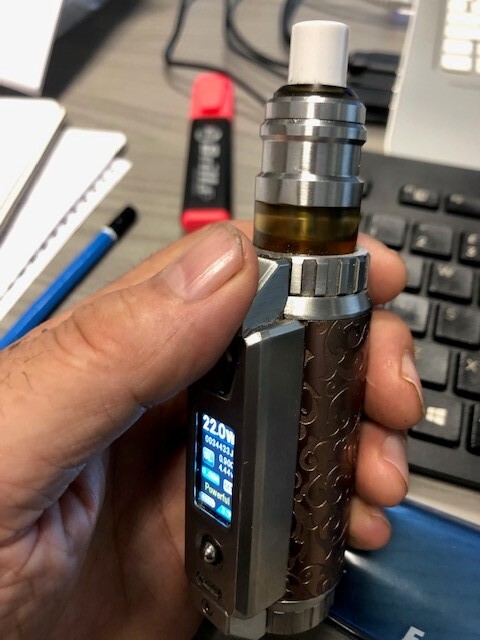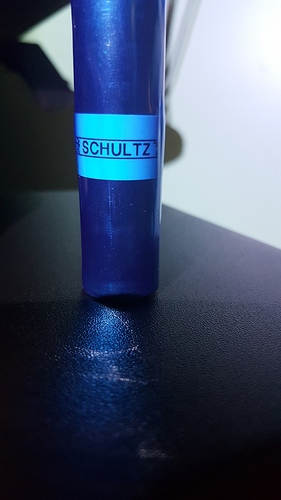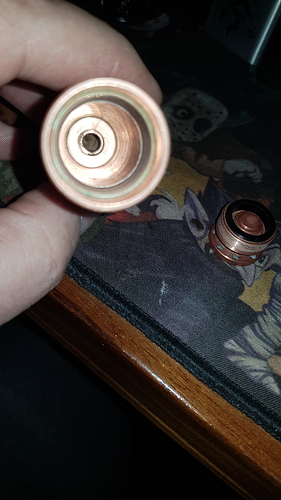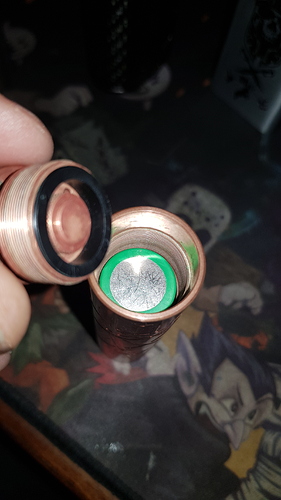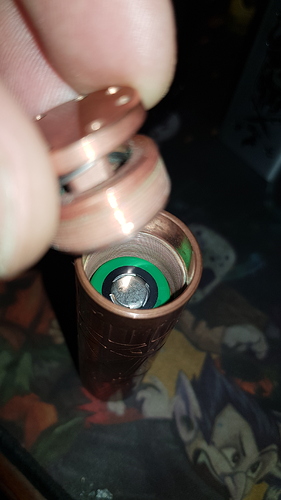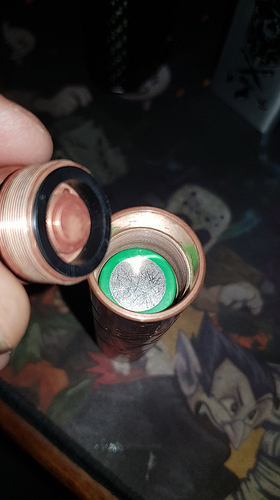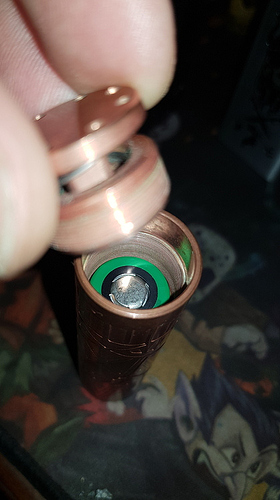It did certainly sound strange but sometimes it is hard to tell with type - i think we need a special I’m kidding font 
Today it’s a Le Zephyr with #400 mesh and a double twisted…
happily filled with an NET Latakia and a Pear layer fusion… yummi
I was also scared for a very long time to rewrap batteries , as a matter of fact I just recently rewrapped my first ones a few months ago after vaping for over 4 years… Let me tell you No worries at all …as long as your using the proper tools all is good
Couple of notes:
Remember to buy the adhesive positive ring, it’s sold in sheets and they will last you a lifetime.
If you cut the old wrap, watch out!! With the cutter you could short the positive!!
Be careful about the wrap measure, make sure the wrap will fit the positive after heating, a slight overlap over the positive ring is enough, but be prepared to do it two or three times before you get the hang of it.
Don’t overheat, don’t use heat guns, lighters (It won’t do a nice job anyway) and the like, an hairdryer is more then enough.
Don’t hold the batteries in your hand, (unless you’re one of those that can stand high heat) and find an hard, heat resistant (not metallic) surface so you can slowly roll the battery when you apply heat.
Start from the positive and slowly move down the battery.
It’s an easy task, but brain switched to “ON” !
I hadn’t thought of that. I use the ring that comes with the cell (LGHG2). It is fine but not adhesive, and after I blew it off with the hair dryer the first time I tried this, I put one tiny drop of super glue on it, and it holds it just fine from now on. Dozens of re-wraps in total and the cyanoacrylate works great and causes no problem. Re-wrapping is essential eventually and also kinda fun too.
*Oh, meant to add. I also put the battery label (it’s matched pair name) on the metal case under the wrap so I don’t have to redo that every time too. I use see-through color wraps so covering the name isn’t an issue.
An unwrapped battery is not going to explode in your hand. Look into how they work because you don’t know right now and as someone who uses them on a daily basis, you would benefit from knowing.
I just keep them in a battery case until I have small stack and take them to the B&M once a year and let them do it. I buy a set of batteries and they’ll re-wrap mine for nothing.
I know. The problem though, is that I am a cheapskate and… Well, that’s basically it, I’m a cheapskate. ![]()
Here is my new and improved video on wrapping batteries. I even do a double wrap.
@Chef_Johnny
In fact, the only part of the battery-cell assembly that matters (in terms of electrical safety concerns) is the region closely surrounding the positive battery terminal itself (which is nearby to negative battery potential). The rest of the outer surface is at negative battery potential (which is generally the same reference ground potential that the mod casing, and any electrical shielding, connects to). (In such cases), there exists no particular compelling electrical safety reason to wrap the rest of the cell - save for some (relatively slight) physically protective effect from impacts with hard, sharp objects. Serial-connected multiple-cell systems (may possibly, depending on the physical design) present more complicated possibilities for short-circuits. If one simply cannot resist pummeling the cell with hard, sharp objects, I suppose wrapping makes sense. It seems to me that rapidly heating the cell when shrinking the wraps represents some (possibly more) danger. Heating the battery cell when it is at a low charge state is likely a safer situation than when it is at full charge. The idea that having little holes in the wrap (itself) may cause fire/explosion strikes me as pure malarkey. ![]()
This is possibly the worst advice I have seen posted for a long long time. Try putting an unwrapped (or damaged wrap) battery in a mech mod (with the positive toward the button mechanism) or in a metal mod that has no insulating sleeve inside the battery compartment.
It is far easier to have people keep their battery wraps in good condition irrelevant of the mod it is going into than deal with the fall out from someone seriously injuring themselves.
SMH
(In the case of a single-battery device, not attempting to address the aforementioned potential complexities of a series-connected multiple battery-cell system), I don’t understand what you are trying to say. You are describing a device where the electrical path leading from a connection to the positive terminal (and on to energize the chip-set driver or coil directly) can be easily electrically contacted by the (rest of the) surface of the battery-cell (which is at negative potential) ? Why would someone design and build (or elect to use) such a seemingly highly unsafe device ? I certainly would not want to have to depend on the thin layer of a battery-wrap to exist as the sole barrier between an insulated and a short-circuited state. Perhaps you could explain further where and how an electrical short circuit (across the battery terminals) would be likely ? Appreciated.
Mooch doesn’t cover single battery mods in this video but instead of you saying it is marlarky we should ALL promote battery safety with best practices.
If you put a battery in any single battery mech it really should be positive up towards the 510 simply because the whole can of the battery and the whole body of the mod are both - ve. If you put the +ve down (away from the 510) then the can of the battery is -ve and the body of the mod is +ve meaning that you are reliant on the protection of the wrap alone to stop a short.
Promote battery safety and change your wraps if they need changing.
Watched the video, thanks for the link.
In fact, his first (of two) scenarios in the video (essentially) does address single battery mods. I was clear about addressing that (single-battery mod) case in my posts. Note that he is describing the importance of the operational functionality of the (upper) insulating ring that encircles the positive voltage potential tab and creates a circular physical insulating gap. Yes indeed. The critical insulation region. Note that my posts specifically address the (separate) wrapping-material (not the upper insulating ring) - and note that I stated that (upper insulating ring) region is the critical location where wrapping-material is required for adequate electrical safety. Consistent with the first scenario appearing in the video. No fuss, no muss, no paranoia.
As for multiple series-connected battery systems (which I specifically did not address in my posts) - yes, if the mod (or mech) design does not (itself) reliably independently insulate all of the surfaces of the multiple batteries from each other (period) - then I would not recommend using the device ! One wrap, double-wrap, to one’s heart’s delight - but leaving one’s fate up to a layer or two of thin plastic strikes me as purposely tempting avoidable disaster. Not design guidance that any competent designer would provide to anyone.
Nothing that I have said is in any way “heretical”. I have an AAS degree in electronic technology, I worked ~10 years as an electronic design and development technician in various companies and fields, worked ~5 years as an electronic designer of professional audio signal processing systems (designing, prototyping, developing, promoting). As stated (specifically relative to the simple single-battery scenario), The idea that having little holes in the wrap (itself) may cause fire/explosion strikes me as pure malarkey. That is true.
Yes, it is (always) important that readers carefully read (and hear) what people specifically, actually mean (where it comes to electrical safety measures and practices). Advice can be a dangerous business - but rationality is preferable to paranoia, and it seems a given that people purporting to speak regarding such matters are wise to know whereof they speak. Comprehension is further required for coherent discourse.
Congratulations - I don’t care. Do what you do.
For everyone else, if your wraps have holes in them spend 5 minutes and change the wraps.
Applying just a spot of somewhat thick and sturdy (and insulating) transparent packing tape works fine, too. If one has (any) insulation issues at the top (in the actually critical region for single-battery-cell short-circuits), then a wrapping-material re-wrap using a new insulating ring would (in such cases) make reasonable sense.
(I would think that) knowing that one does not (necessarily) need to unnecessarily fear wrapping-material holes (located outside of the critical upper battery-top area) would be re-assuring knowledge. Battery fires and explosions are certainly no joke whatsoever. Rational understandings about what is actually happening (or could potentially happen) make sense. Imagined problems may have a way of detracting from real ones.
Every day lately, the “vaping communities” are suffering from phantasmagorial thinking (with respect to knowledge surrounding toxicological dangers) - which should rightly be doubted and questioned, and not summarily embraced simply “because somebody else said so”. I am simply applying similar rationality to matters of electrical circuitry. If you can’t believe a degreed electronic tech/designer, who can you believe ?
Oh you mean everyone should believe you because you say it is so - just like we can believe all the doctors, media and officials of the governments out there - hmm no thanks.
Let me explain with pictures since it appears you totally don’t understand the words I am saying (maybe it is me not being clear)
Take this copper mech mod
If I put the battery in like this
Then the whole body of the mod is negative and the state of the wraps will really be of no consequence since the whole body of the battery is also negative.
Whereas if I put the battery in like so
Then the whole body of the mod is now positive should there be a tear or a hole in the wrap and should the negative body of the battery come in contact with the sidewall of the mod then it will short and may create a situation where the battery can explode.
I don’t care if you have 50 degrees and worked for 100 years in electronic design you are preaching bad safety and should be called out on it. How hard is it for you to understand that it is safer to rewrap a battery than to leave it? I mean really the whole idea of vaping is risk minimisation so why not minimise the risk and rewrap. What you are saying is don’t sweat it I know my stuff it will never happen I am sure that would be of comfort to someone who takes your advice and bad things happen.
Thanks for the images and your specific presentation. You seem to be describing a device that places the entire (electrically conductive) body of the device at the same electrical potential as is applied to the small sized copper-colored electrical terminal shown in the piece that is being held between fingers on the left side of the image (below):
… so that in the alternative configuration (where the battery is presumably properly inserted), the entire body of the device is placed at a positive voltage potential (measured relative to the negative terminal of the battery) in the image (below):
I own, use, and have made various measurements on my Sigelei 30Ws and an eLeaf Pico 25. In both cases, “case ground” (entire body of the device) is not connected to the 510 connector intended for connection to a positive power supply voltage potential - it is instead connected to the electrical terminal on the devices that (normally, when properly installed) connects to the negative terminal of the single battery.
The measured device characteristics are in that sense fundamentally different than what you appear (if I understand you correctly) to be describing - and (in the case of my particular devices), the danger of short-circuit (along the lines of what you describe) could only occur in a scenario where the battery was inserted backwards (that is, incorrectly installed) - (if) the outer wrapping-material allows electrical current flow through some opening(s). Why would one endeavor to design and construct (much less distribute) such a device - that would (as you have described it), operate in distinct danger of a dangerous electrical short-circuit evolving through breaches in wrapping-material ? Seems like a completely avoidable short-circuit risk.
(Such a device design) makes no rational sense to me. Perhaps you can enlighten me as to where I have strayed ? Our mod devices (as electrically measured) seem to exist on polar opposite sides of some proverbial “looking glass”. Thanks for your thoughtful consideration. It would be nice to understand your technical views as presented (in your post here replied to). And of course, safety is the common goal.
As someone who still uses mech mods from time to time excellent posts @woftam. I don’t review or recommend mech mods for this very reason, not for the mods themselves but for the battery care that needs to be taken. Mechanical mods are safe depending on the user and that is a HUGE point. I am extremely careful when it comes to mechs, justifiable so when you think of the consequences. Everyone else should have the same respect, if not stick with regulated mods but mind your batteries regardless.
Any questions about your battery wraps then fix that issue, cheap when you think about the potential consequences. Dented or questionable batteries? Recycle them, the cost is definitely not worth the risk.
That is what I specified in my first post MECH mod - the mod will fire in either configuration the correct one in my opinion is with the positive down (towards the hybrid 510 hole) as in photo 2.
Regardless of which orientation the battery is in a mech, the type of mod mech/regulated the wraps should always be kept in good condition.
You ask why use such a device I can think of lots of reasons the major one being my mech mods will still work many many years after the electronics in your Sigelei and your Pico have failed and become land fill.
Wow.
That’s a lot of talk.
I’m gonna re-wrap my bad batteries because if the devil doesn’t like it he can sit on a tack.
